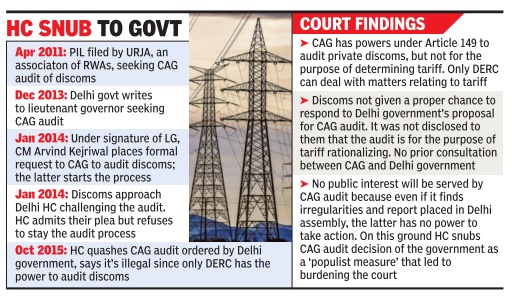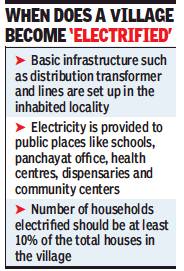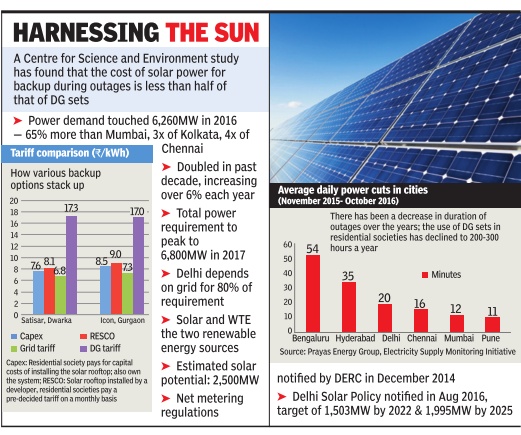Electricity, supply of: India
This is a collection of articles archived for the excellence of their content. Readers will be able to edit existing articles and post new articles directly |
Contents |
Discoms, private
CAG cannot audit private discoms: HC
The Times of India, Oct 31 2015
Abhinav Garg
Blow to Kejri: CAG can't audit discoms
In a blow to the Kejriwal government, Delhi high court on Friday struck down its decision to get power discoms audited by CAG. It pointed out that there was a regulator, Delhi Electricity Regulatory Commission, for auditing the accounts of private discoms for tariff determination and CAG could not usurp that role. A bench of Chief Justice G Rohini and Justice Rajiv Sahai Endlaw observed that the purpose of the CAG audit -to examine if power tariffs were properly determined -was the exclusive domain of DERC. Thus, the purpose of the audit wasis not if privatisation has ser ved any purpose or whether the terms of the transfer scheme were in the interest of the Delhi government. The sole purposepurport of the audit is tariff determination,“ the bench observed, faulting the process.
The pre-poll promise that resulted in a formal request to CAG to carry out an audit of discoms in January 2014 was described as a “populist measure“ by the court which questioned the public interest behind the exercise. Since the state government and Delhi assembly have no power to take action on the findings, the court said it “ultimately may serve no purpose“.
“Such populist measures...not only end up being contrary to public interest but also put an unnecessary burden on the courts,“ the bench noted, quashing Delhi government's January 7, 2014 direction for the CAG audit.
Even as it recognized the constitutional powers of CAG, the bench faulted the Delhi government for rushing through the audit request instead of inviting objections from the discoms to a CAG au dit. “What emerges is that the discoms were given an oppor unity to represent (their point of view) before consul ations had taken place be ween the administrator and CAG and before the terms and conditions of such audit had been agreed upon between CAG and the concerned government,“ the court noted, cancelling the audit on this preliminary ground.
In its 139-page verdict, the court also criticised the government for not empowering DERC and instead embarking on “a misguided exercise by directing the CAG audit when ts report would not have any sanctity in law for achieving the desired result.“
“The direction for audit of discoms by CAG, when the report of CAG cannot impact the tariff, would not also serve any public interest,“ the court noted, lamenting that four years were wasted when “what was sought to be achieved could have been achieved by invoking the powers of DERC.“
The judges said “we are unable to decipher anything which DERC cannot but CAG can unearth“, pointing out that “once by law a regulatory body has been constituted with powers to have the ac counts of the discoms audited, there can be no other audit at the instance of the state government.“
It disagreed with the stand of the government and of an NGO that filed the PIL United RWAs Joint Action (URJA) that the audit was ordered in public interest for determining the tariff.
The court said that “determination of tariff is in sole domain of DERC which is well-empowered to itself conduct the same, and the report of the CAG audit has no place in the regulatory regime brought about by the Electricity Act and the Reforms Act.“
HC differentiates between audit of discoms, telcos
The Times of India, Oct 31 2015
Abhinav Garg

HC draws line between audit of discoms, telcos
With its verdict, the Delhi high court made an exception even though the Supreme Court had held earlier that large private corporations benefiting from state funding must face the national auditor. In fact, last year, an HC bench of Justices Pradeep Nandrajog and V Kameswar Rao had also allowed auditing of private telecom firms. HC had permitted CAG to go ahead with its scrutiny despite claims by private telecom companies that they already had in place a mechanism of special audit as envisaged in the licence agreement between them and the department of telecommunications. The telcos also argued that they operated in a regulatory regime under TRAI. But HC, dealing with sections 13 and 16 of CAG Act, held CAG has independent powers to audit, irrespective of other licences, rules and agreements between govern ment and private players.
Later, an SC bench of Jus ices K S Radhakrishnan and J S Khehar upheld the verdic by observing that the telecom spectrum is a scarce, valuable resource and a private firm using it on behalf of the gov ernment should be subjected o CAG audit.
In its verdict on Friday, the bench showed it is aware o the SC ruling but went on to differentiate the discoms' PIL from the telecom case. Writing for the bench, Justice R S Endlaw said CAG's powers to audit the firms are limited to “any of the transaction of Delhi government with discoms in the matter of transfer scheme“, which means the entire privatisation process.
But the court struck down the audit as “the reason for which audit has been directed is not to examine the transaction but on the suspicion of tariff having not been proper ly determined and which is in exclusive domain of DERC“.
CAG's standing counsel, Gaurang Kanth explained the difference: “HC upheld our contention, accepted and reiterated the fact that CAG is the fourth pillar of the Constitution and can audit a pri vate body or authority . But in the present case, it observed that the government has not followed the procedure prescribed for the CAG audit.“
Electrification, spread and reach of
2018: All villages in India have electricity
All villages in India now have access to electricity, April 30, 2018: The Times of India

From: All villages in India now have access to electricity, April 30, 2018: The Times of India
Next Challenge: To Get Power To All Households
Manipur’s Leisang village became the last non-electrified inhabited village to join India’s mainline supply network at 5.30pm on Saturday, a key milestone in the country’s journey towards universal electricity access.
This means that all 597,464 inhabited villages in the country now have access to power. On August 15, 2015, PM Narendra Modi had announced that all unelectrified villages would get power over the next 1,000 days.
The last inhabited village to be powered through the offgrid system — isolated supply networks, mostly with solar power plants — was Pakol, also in Manipur.
While basic infrastructure such as distribution transformer and lines need to be set up in inhabited localities, including Dalit hamlets, a village is considered electrified if 10% of its households and public places such as schools, panchayat office and health centre have access to electricity.
“28th April 2018 will be remembered as a historic day in the development journey of India. Yesterday, we fulfilled a commitment due to which the lives of several Indians will be transformed forever. I am delighted that every single village of India now has access to electricity,” PM Modi tweeted on Sunday.
While villages have the power infrastructure, it is now up to households to seek a connection and for state governments to ensure supply.
Power scheme inspired by Modi’s experiment as CM
At the time of Modi’s announcement in August 2015, data showed 18,452 villages without power. When work on village electrification started, another 1,275 villages were found to be without access to electricity. Some 1,200 villages are uninhabited and 35 were notified as grazing reserves.
“Village electrification means that the infrastructure to supply power has now reached certain parts of the village. The next step should be to focus on providing connection to all households and ensuring adequate power supply to these homes,” former power secretary P Uma Shankar said.
“Village electrification and household electrification are different things. It is up to the people to seek a connection,” added another former power secretary, R V Shahi .
The real challenge now is to feed power to each household in those villages, a task being undertaken through the Saubhagya scheme.
Data on the official scheme website showed that in mid-October 2017, of 18 crore rural households, around 82% or 14.8 crore were electrified. But there was wide variation across states, with those such as Tamil Nadu and Andhra Pradesh showing 100% coverage, while only 55% of the households in UP and 48% in Jharkhand were electrified.
The seeds of 100% village electrification were sowed with the Deen Dayal Upadhyay Gram Jyoti Yojana, a scheme with a projected outlay of Rs 76,000 crore, that Modi had launched on July 25, 2015. The scheme drew from Modi’s successful experiment as Gujarat CM to separate farm and household feeders in rural areas to ensure 24x7 power to households and assured supply to farmers.
One of the key objectives of the DDUGJUY was to achieve 100% village electrification. It also envisaged separating feeders, strengthening distribution network, metering at all levels.
…but 16.3cr people do not have electricity

ii) Electrification in India, 2014- 18; and iii) States with the highest number of un-electrified villages in 2014.
From: May 2, 2018: The Times of India
See graphic:
i) Electrification in India, 1950-April 2014;
ii) Electrification in India, 2014- 18; and iii) States with the highest number of un-electrified villages in 2014.
2019 Feb: 99.9% households electrified
Only 28k households left to be electrified, February 11, 2019: The Times of India

From: Only 28k households left to be electrified, February 11, 2019: The Times of India
Target Of 2.5Cr Households To Be Met By Feb-End
Just about 28,500 or 0.1% of households in a clutch of five districts across the country remain unelectrified amid expectation that full electrification will be completed by the month-end, bringing to conclusion an ambitious project to take electricity to all villages.
Data on the government website showed that around 8,500 households were yet to be electrified in Rajasthan’s Udaipur district. Similarly, in Chhattisgarh, around 20,000 households need to be provided connections in Bijapur, Narayanpur, Dantewada and Sukma, which are severely hit by Left-wing extremism. The remaining households are spread over 553 villages.
The overall pace of the scheme’s target to deliver electricity connections to 2.5 crore households indicates that the task may be complete well before the March deadline. This will mark a major step after the electrification of 19,614 villages.
The decision to aim for electrification of all willing households was taken after some deliberation, according to an official who said that initially the plan was to set all mohallas or localities in a town or village as the target. But this would have missed out on households and after more deliberations, PM Narendra Modi gave the nod for a much more challenging goal.
“We have done over 2.48 crore households so far and we hope to meet the target in the next 10-12 days,” said an official. Sources said power minister R K Singh has been in contact with state governments to ensure all households are provided connections at the earliest. He has spoken to CMs, asking them to help meet the household electrification targets and prevent their states from being outliers.
Electrification of all households under PM Saubhagya scheme is a flagship programme of the Modi government, which had advanced the deadline to December but officials said they are well on their way to meet the target before the original deadline of March. When the scheme started, there were around 4 crore unelectrified households in the country.
The highest number was in UP, which now claims to have provided connections to all households that came forward. “We have changed the entire electrification lexicon. If it was still reaching out to villages or mohallas, then many households would have been left behind despite the government sinking in large amount of funds,” said an official.
Initiatives by the government
September 2017/ PM Sahaj Bijli Har Ghar Yojana (Saubhagya)
Free connections
Under the PM Sahaj Bijli Har Ghar Yojana (Saubhagya), every household in the country will be given an electricity connection. No price will be charged for the poor to get an electricity connection and the government will go to their houses to give them the connection.
The government will bear the expected ₹16,000 crore cost of giving electricity connections to the 4 crore households in the country.
“It’s been over 125 years when the famous scientist Thomas Alva Edison invented the bulb and who had said: ‘We will make electricity so cheap that only the rich will burn candles’,” the PM stressed, highlighting that it is unfortunate that yet many households are lit with the help of candles or lanterns.
“Forgot about conveniences, even the women of the house have to cook in the dark, which is why most of them are under pressure to try and finish the cooking before the sun sets,” Mr. Modi said, after inaugurating the Deen Dayal Urja Bhavan, a new green building built by public sector oil explorer ONGC in the capital.
Power cuts/ outages; power supply
1992-2016

See graphic, ' Power shortage in India, requirement and availability, 1992-2016, year-wise '
Nov 2015-Oct 2016

See graphic, ' Average daily power cuts in major cities, Nov 2015-Oct 2016 '